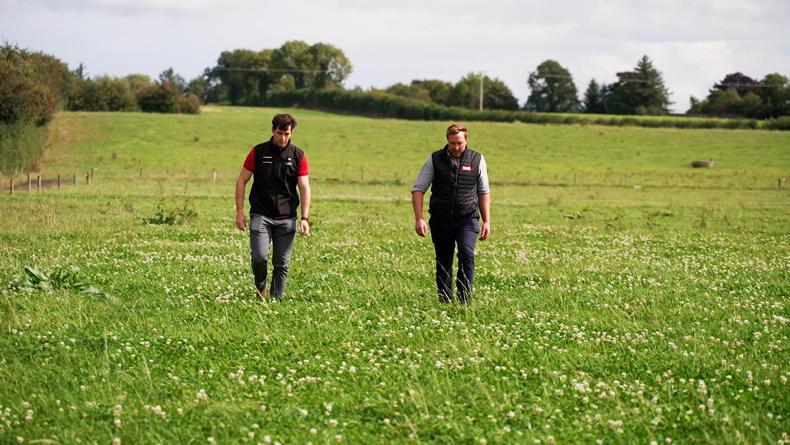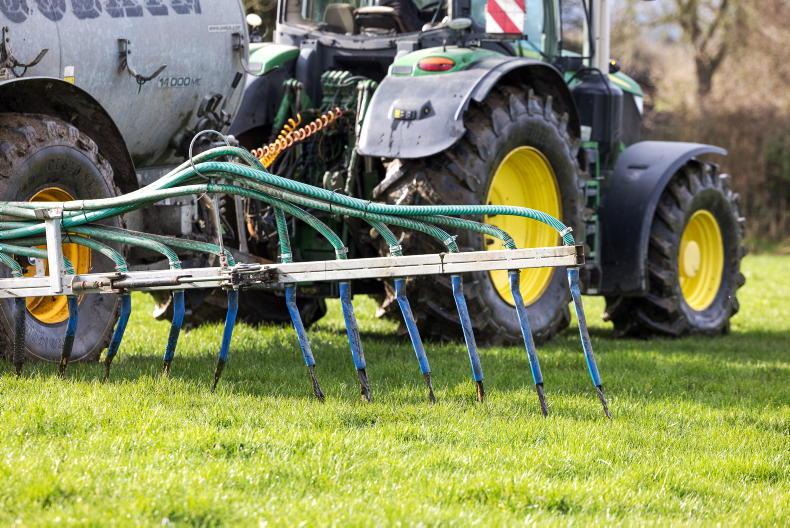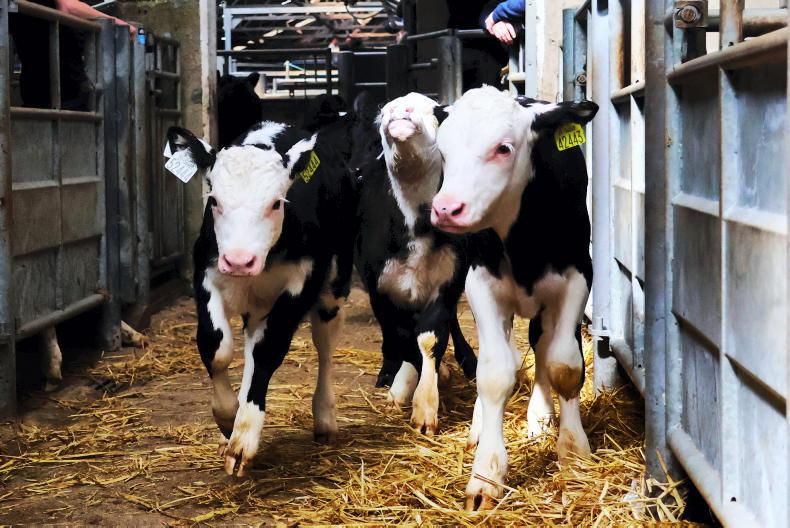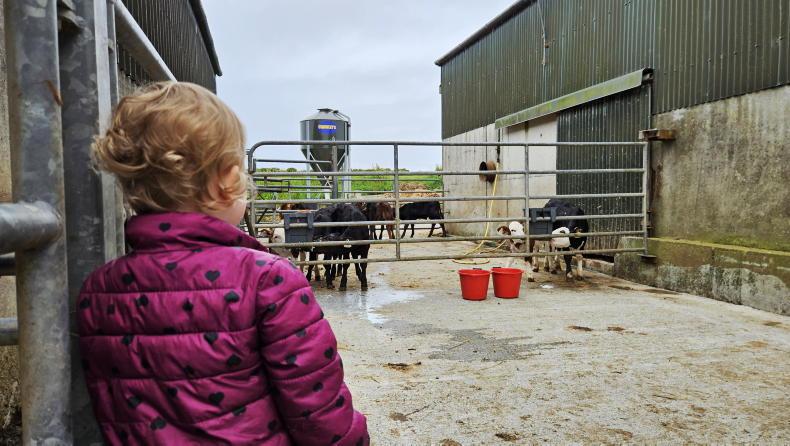Increased cow numbers on dairy farms, coupled with increased adoption of improved breeding technologies (economic breeding index, synchronised breeding programmes, sexed semen, etc) have resulted in consistent improvements in the six-week calving rates on Irish dairy farms in recent years.
This has resulted in large numbers of additional male calves being born each spring (Figure 1).
While this trend has substantial benefits for the productivity of dairy farms (increased lactation length and pasture utilisation), it has nonetheless created additional pressures in managing the peak calving period in terms of skilled labour supply and the adequacy of calf-rearing facilities.
An additional consequence of the increased seasonality of male dairy calf production is a substantial increase in both the number and proportion of dairy-sired male calves being born during early spring (Figure 1 and 2).
Indeed, during February alone, the number of dairy-sired male calves born has increased by 78% during the last decade.
As a result, the number of farm-to-farm movements of unweaned calves (less than six weeks old) and abattoir slaughtering of calves under one year have both increased substantially during the same period (Figure 3).
In addition to the increased supply of male dairy-sired calves, the continued transport of live animals and, in particular, young dairy calves is a growing concern.
Although the proportion of unweaned calves which are exported live from Ireland has remained relatively constant over time, a recent proposed ban on the transport of young unweaned calves by the European Parliament’s Committee on Inquiry on the Protection of Animals during Transport (ANIT) could have substantial additional implications for the continued export of almost 30% of all male dairy-sired calves born in Ireland each year.
EveryCalf: dairy calf to beef with commercial rearers
The increase in farm-to-farm sales in Figure 3 is indicative of the increasing numbers of male dairy calves reared to beef in Ireland in recent years.
In response to the requirement for additional models of male dairy calf rearing, Teagasc has developed a project looking at the biological performance of male dairy and dairy beef calves in partnership with commercial rearing farms.
The objective of the EveryCalf project is to evaluate the potential for profitable dairy calf-to-beef systems in collaboration with commercial rearing farmers.
Teagasc and 10 drystock farmers have entered a collaborative arrangement where the drystock farmers will contract-rear the entire male progeny from five Teagasc dairy research farms (Moorepark, Kilworth, Curtins, Clonakilty and Ballyhaise) each year.
Teagasc retains full ownership and risk associated with the potential market value of the animal at the end of the rearing period
The rearers were selected as Teagasc clients who are members of Teagasc discussion groups and who have demonstrated their capacity to achieve target weights as existing heifer contract-rearers.
Teagasc retains full ownership and risk associated with the potential market value of the animal at the end of the rearing period, while the rearers are paid a daily rate subject to the achievement of target animal weight gain.
The calves are contract-reared from three weeks of age to 14 months of age (mid-April of the subsequent year) or 330kg liveweight on the 10 rearing farms.
Thereafter, 60% of the animals are either retained or moved to a grazier and finishing units for slaughter at 24 months with the remaining 40% evaluated for feed and methane efficiency during finishing and meat character at slaughter within the ICBF National Progeny Test Evaluation Centre at Tully, Co Kildare.
In addition to the rearing of animals via commercial rearing agreements, the project is unique as all male animals generated within the source herds comprising various breeds are included in the study.
All animals are weighed by Teagasc every six weeks during the programme to monitor animal performance.
The project ran for three years (2020 to 2022 inclusive).
A complete financial analysis will be undertaken and published at the end of the rearing period to evaluate the potential of the project to increase the value of male progeny from the dairy herd.
As part of the programme, the calf rearers will be provided with substantial advisory backup and advice and the programme is based on a pre-agreed protocol and contract-rearing agreement.
In total, 422 male dairy calves were enrolled in the project in 2020, with a further 374 added in 2021 and 320 during 2022. Mortality rates have been kept at below the target level of 3% during the initial three years of the project.
The breed composition of the calves was 60% dairy (with equal parts Holstein-Friesian (HF), Holstein-Friesian cross (FRX) and Jersey Holstein-Friesian cross(JFX)) and 40% dairy beef cross (primarily Aberdeen Angus (AAX) but also including Limousin (LMX), Hereford (HEX), Charolais (CHX), Belgian Blue (BBX) and Aubrac (AUX)). The mean carcase breeding value (BV) of the calves born was -5kg based on a maternal population with an average economic breeding index of €190 and a beef sub-index of €-15.
The mean birth weight of the calves was 37kg, and these were moved on average at 30 days of age (and 54kg liveweight (LW)) to the rearing farms. All calves were weaned at 63 days of age when eating in excess of 1kg of concentrate per day.
During the first grazing season, all calves averaged 0.75kg average daily gain (ADG kg LW/hd/d) on a predominantly pasture-only diet.
During the winter, average mean ADG was 0.7kg. Thereafter, the calves achieved an ADG of 0.79kg during the second grazing season and reached an average LW of 486kg at the beginning of the finishing period.
For the initial animals slaughtered within the project, the mean LW at slaughter was 585kg corresponding to a mean lifetime ADG of 0.75kg/d.
The mean kill date was 4 February 2022 (718 days; 24 months), resulting in a mean carcase weight of 293kg (and killout of 50%) with a mean net carcase value of €1,288 (€4.34/kg).
The mean conformation of all animals slaughtered was O- while the mean fat score was 3=.
The initial evaluation of the slaughter data indicates the strong genetic influence on final carcase weight.
Finance
In addition to the LW performance, the project also affords the opportunity to closely monitor financial characteristics of dairy calf-to-beef production systems on commercial farms.
The estimated rearing costs from arrival on farm to slaughter was €1,173 for the initial animals within the study, leaving a residual value of €115 to cover the cost of the calf and rearing costs during the first 28 days of life.
Net profit margins on rearing farms ranged from €0.20 to €0.44 per animal per day during year one to remunerate the rearers for their own labour and land.
Benefits for dairy farmers
Additional land, labour and facilities provided: as the contract-rearer is completing all works associated with the management and rearing of these calves, they are in effect providing:Labour – very difficult to source reliable, skilled workers.
Facilities – reduced need for capital expenditure where calf housing, feeding systems and feed storage areas and slurry storage are provided for.
Land – removes the exposure to high rental/purchase costs associated with compliance with nitrates regulations on dairy farms.Ease of management: reduced numbers and groups of animals on the farm, allows for increased efficiency, improved management and reduces the disease pressure on the remaining heifer calves in the calf housing area.Increased milk production and profitability: additional lands are now available for grazing or fodder production allowing increased milk output or reducing the need to purchase forage, thereby increasing farm profitability if completed in an efficient manner.Contract-rearing provides an opportunity for non-dairy farmers to devise an alternative system, in the knowledge that in return for good performance they will be rewarded for their land, labour and management through a pre-agreed monetary rate.
The objective of the EveryCalf project is to evaluate the potential for profitable dairy calf-to-beef systems in collaboration with commercial rearing farmers
For the dairy farmer, removing animals at an early age, reducing the need for additional facilities, labour, etc, and the opportunity to allocate more time and resources to the main cow herd can be very beneficial.
Aim
The objective of the EveryCalf project is to evaluate the potential for profitable dairy calf-to-beef systems in collaboration with commercial rearing farmers.
In doing so, the ambition of the programme is to optimise male dairy performance and welfare, enhance the profitability of dairy beef rearing systems and build greater market linkages between dairy farmers and beef finishing systems on Irish farms.
The preliminary results from the project are indicative of the potential of high-quality pasture management on commercial farms to deliver excellent animal performance in dairy calf-to-beef systems and provide a strong basis for the development of such operations into the future.
To further improve the efficiency of dairy calf-to-beef systems, the results of the study show the significant impact of calf commercial beef value on subsequent animal performance within such systems.
Increased cow numbers on dairy farms, coupled with increased adoption of improved breeding technologies (economic breeding index, synchronised breeding programmes, sexed semen, etc) have resulted in consistent improvements in the six-week calving rates on Irish dairy farms in recent years.
This has resulted in large numbers of additional male calves being born each spring (Figure 1).
While this trend has substantial benefits for the productivity of dairy farms (increased lactation length and pasture utilisation), it has nonetheless created additional pressures in managing the peak calving period in terms of skilled labour supply and the adequacy of calf-rearing facilities.
An additional consequence of the increased seasonality of male dairy calf production is a substantial increase in both the number and proportion of dairy-sired male calves being born during early spring (Figure 1 and 2).
Indeed, during February alone, the number of dairy-sired male calves born has increased by 78% during the last decade.
As a result, the number of farm-to-farm movements of unweaned calves (less than six weeks old) and abattoir slaughtering of calves under one year have both increased substantially during the same period (Figure 3).
In addition to the increased supply of male dairy-sired calves, the continued transport of live animals and, in particular, young dairy calves is a growing concern.
Although the proportion of unweaned calves which are exported live from Ireland has remained relatively constant over time, a recent proposed ban on the transport of young unweaned calves by the European Parliament’s Committee on Inquiry on the Protection of Animals during Transport (ANIT) could have substantial additional implications for the continued export of almost 30% of all male dairy-sired calves born in Ireland each year.
EveryCalf: dairy calf to beef with commercial rearers
The increase in farm-to-farm sales in Figure 3 is indicative of the increasing numbers of male dairy calves reared to beef in Ireland in recent years.
In response to the requirement for additional models of male dairy calf rearing, Teagasc has developed a project looking at the biological performance of male dairy and dairy beef calves in partnership with commercial rearing farms.
The objective of the EveryCalf project is to evaluate the potential for profitable dairy calf-to-beef systems in collaboration with commercial rearing farmers.
Teagasc and 10 drystock farmers have entered a collaborative arrangement where the drystock farmers will contract-rear the entire male progeny from five Teagasc dairy research farms (Moorepark, Kilworth, Curtins, Clonakilty and Ballyhaise) each year.
Teagasc retains full ownership and risk associated with the potential market value of the animal at the end of the rearing period
The rearers were selected as Teagasc clients who are members of Teagasc discussion groups and who have demonstrated their capacity to achieve target weights as existing heifer contract-rearers.
Teagasc retains full ownership and risk associated with the potential market value of the animal at the end of the rearing period, while the rearers are paid a daily rate subject to the achievement of target animal weight gain.
The calves are contract-reared from three weeks of age to 14 months of age (mid-April of the subsequent year) or 330kg liveweight on the 10 rearing farms.
Thereafter, 60% of the animals are either retained or moved to a grazier and finishing units for slaughter at 24 months with the remaining 40% evaluated for feed and methane efficiency during finishing and meat character at slaughter within the ICBF National Progeny Test Evaluation Centre at Tully, Co Kildare.
In addition to the rearing of animals via commercial rearing agreements, the project is unique as all male animals generated within the source herds comprising various breeds are included in the study.
All animals are weighed by Teagasc every six weeks during the programme to monitor animal performance.
The project ran for three years (2020 to 2022 inclusive).
A complete financial analysis will be undertaken and published at the end of the rearing period to evaluate the potential of the project to increase the value of male progeny from the dairy herd.
As part of the programme, the calf rearers will be provided with substantial advisory backup and advice and the programme is based on a pre-agreed protocol and contract-rearing agreement.
In total, 422 male dairy calves were enrolled in the project in 2020, with a further 374 added in 2021 and 320 during 2022. Mortality rates have been kept at below the target level of 3% during the initial three years of the project.
The breed composition of the calves was 60% dairy (with equal parts Holstein-Friesian (HF), Holstein-Friesian cross (FRX) and Jersey Holstein-Friesian cross(JFX)) and 40% dairy beef cross (primarily Aberdeen Angus (AAX) but also including Limousin (LMX), Hereford (HEX), Charolais (CHX), Belgian Blue (BBX) and Aubrac (AUX)). The mean carcase breeding value (BV) of the calves born was -5kg based on a maternal population with an average economic breeding index of €190 and a beef sub-index of €-15.
The mean birth weight of the calves was 37kg, and these were moved on average at 30 days of age (and 54kg liveweight (LW)) to the rearing farms. All calves were weaned at 63 days of age when eating in excess of 1kg of concentrate per day.
During the first grazing season, all calves averaged 0.75kg average daily gain (ADG kg LW/hd/d) on a predominantly pasture-only diet.
During the winter, average mean ADG was 0.7kg. Thereafter, the calves achieved an ADG of 0.79kg during the second grazing season and reached an average LW of 486kg at the beginning of the finishing period.
For the initial animals slaughtered within the project, the mean LW at slaughter was 585kg corresponding to a mean lifetime ADG of 0.75kg/d.
The mean kill date was 4 February 2022 (718 days; 24 months), resulting in a mean carcase weight of 293kg (and killout of 50%) with a mean net carcase value of €1,288 (€4.34/kg).
The mean conformation of all animals slaughtered was O- while the mean fat score was 3=.
The initial evaluation of the slaughter data indicates the strong genetic influence on final carcase weight.
Finance
In addition to the LW performance, the project also affords the opportunity to closely monitor financial characteristics of dairy calf-to-beef production systems on commercial farms.
The estimated rearing costs from arrival on farm to slaughter was €1,173 for the initial animals within the study, leaving a residual value of €115 to cover the cost of the calf and rearing costs during the first 28 days of life.
Net profit margins on rearing farms ranged from €0.20 to €0.44 per animal per day during year one to remunerate the rearers for their own labour and land.
Benefits for dairy farmers
Additional land, labour and facilities provided: as the contract-rearer is completing all works associated with the management and rearing of these calves, they are in effect providing:Labour – very difficult to source reliable, skilled workers.
Facilities – reduced need for capital expenditure where calf housing, feeding systems and feed storage areas and slurry storage are provided for.
Land – removes the exposure to high rental/purchase costs associated with compliance with nitrates regulations on dairy farms.Ease of management: reduced numbers and groups of animals on the farm, allows for increased efficiency, improved management and reduces the disease pressure on the remaining heifer calves in the calf housing area.Increased milk production and profitability: additional lands are now available for grazing or fodder production allowing increased milk output or reducing the need to purchase forage, thereby increasing farm profitability if completed in an efficient manner.Contract-rearing provides an opportunity for non-dairy farmers to devise an alternative system, in the knowledge that in return for good performance they will be rewarded for their land, labour and management through a pre-agreed monetary rate.
The objective of the EveryCalf project is to evaluate the potential for profitable dairy calf-to-beef systems in collaboration with commercial rearing farmers
For the dairy farmer, removing animals at an early age, reducing the need for additional facilities, labour, etc, and the opportunity to allocate more time and resources to the main cow herd can be very beneficial.
Aim
The objective of the EveryCalf project is to evaluate the potential for profitable dairy calf-to-beef systems in collaboration with commercial rearing farmers.
In doing so, the ambition of the programme is to optimise male dairy performance and welfare, enhance the profitability of dairy beef rearing systems and build greater market linkages between dairy farmers and beef finishing systems on Irish farms.
The preliminary results from the project are indicative of the potential of high-quality pasture management on commercial farms to deliver excellent animal performance in dairy calf-to-beef systems and provide a strong basis for the development of such operations into the future.
To further improve the efficiency of dairy calf-to-beef systems, the results of the study show the significant impact of calf commercial beef value on subsequent animal performance within such systems.









SHARING OPTIONS